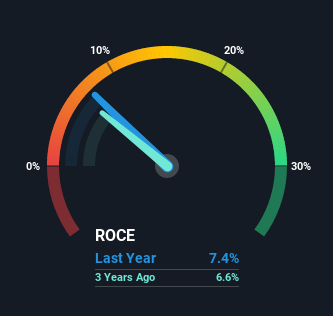- Mexico
- /
- Oil and Gas
- /
- BMV:VISTA A
Slowing Rates Of Return At Vista Oil & Gas. de (BMV:VISTAA) Leave Little Room For Excitement

If you're looking for a multi-bagger, there's a few things to keep an eye out for. Firstly, we'll want to see a proven return on capital employed (ROCE) that is increasing, and secondly, an expanding base of capital employed. Ultimately, this demonstrates that it's a business that is reinvesting profits at increasing rates of return. However, after investigating Vista Oil & Gas. de (BMV:VISTAA), we don't think it's current trends fit the mold of a multi-bagger.
Return On Capital Employed (ROCE): What is it?
If you haven't worked with ROCE before, it measures the 'return' (pre-tax profit) a company generates from capital employed in its business. The formula for this calculation on Vista Oil & Gas. de is:
Return on Capital Employed = Earnings Before Interest and Tax (EBIT) ÷ (Total Assets - Current Liabilities)
0.074 = US$92m ÷ (US$1.6b - US$355m) (Based on the trailing twelve months to September 2021).
Therefore, Vista Oil & Gas. de has an ROCE of 7.4%. On its own, that's a low figure but it's around the 9.3% average generated by the Oil and Gas industry.
See our latest analysis for Vista Oil & Gas. de

Above you can see how the current ROCE for Vista Oil & Gas. de compares to its prior returns on capital, but there's only so much you can tell from the past. If you'd like, you can check out the forecasts from the analysts covering Vista Oil & Gas. de here for free.
How Are Returns Trending?
There are better returns on capital out there than what we're seeing at Vista Oil & Gas. de. The company has employed 32% more capital in the last three years, and the returns on that capital have remained stable at 7.4%. Given the company has increased the amount of capital employed, it appears the investments that have been made simply don't provide a high return on capital.
On another note, while the change in ROCE trend might not scream for attention, it's interesting that the current liabilities have actually gone up over the last three years. This is intriguing because if current liabilities hadn't increased to 22% of total assets, this reported ROCE would probably be less than7.4% because total capital employed would be higher.The 7.4% ROCE could be even lower if current liabilities weren't 22% of total assets, because the the formula would show a larger base of total capital employed. With that in mind, just be wary if this ratio increases in the future, because if it gets particularly high, this brings with it some new elements of risk.
The Bottom Line On Vista Oil & Gas. de's ROCE
In conclusion, Vista Oil & Gas. de has been investing more capital into the business, but returns on that capital haven't increased. And investors appear hesitant that the trends will pick up because the stock has fallen 15% in the last three years. On the whole, we aren't too inspired by the underlying trends and we think there may be better chances of finding a multi-bagger elsewhere.
On a final note, we found 2 warning signs for Vista Oil & Gas. de (1 shouldn't be ignored) you should be aware of.
While Vista Oil & Gas. de isn't earning the highest return, check out this free list of companies that are earning high returns on equity with solid balance sheets.
New: Manage All Your Stock Portfolios in One Place
We've created the ultimate portfolio companion for stock investors, and it's free.
• Connect an unlimited number of Portfolios and see your total in one currency
• Be alerted to new Warning Signs or Risks via email or mobile
• Track the Fair Value of your stocks
Have feedback on this article? Concerned about the content? Get in touch with us directly. Alternatively, email editorial-team (at) simplywallst.com.
This article by Simply Wall St is general in nature. We provide commentary based on historical data and analyst forecasts only using an unbiased methodology and our articles are not intended to be financial advice. It does not constitute a recommendation to buy or sell any stock, and does not take account of your objectives, or your financial situation. We aim to bring you long-term focused analysis driven by fundamental data. Note that our analysis may not factor in the latest price-sensitive company announcements or qualitative material. Simply Wall St has no position in any stocks mentioned.
About BMV:VISTA A
Vista Energy. de
Through its subsidiaries, engages in the exploration and production of oil and gas in Latin America.
Good value with reasonable growth potential.


